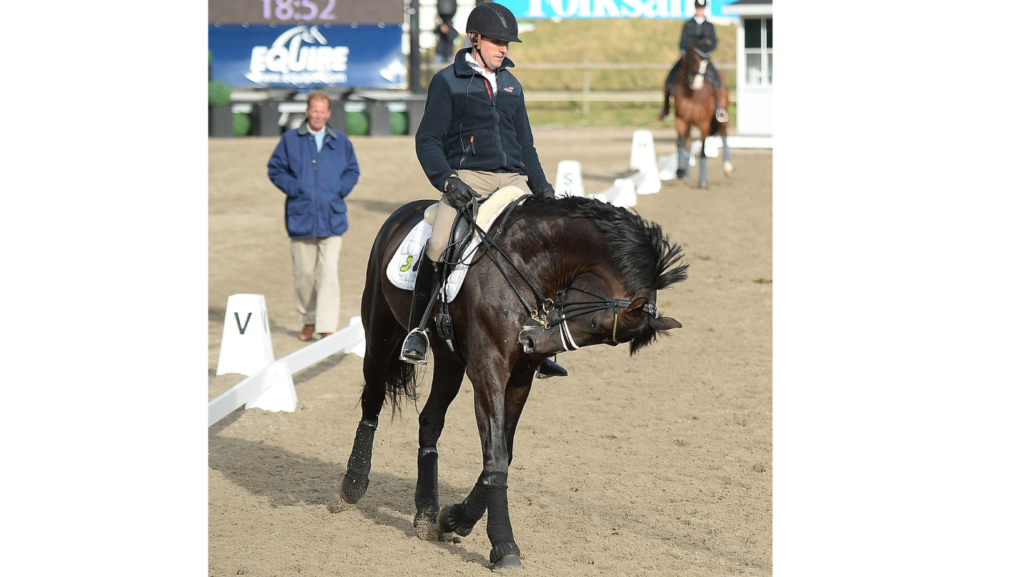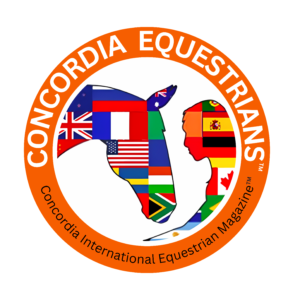THE OPEN USE OF ROLLKUR & LDR
By veterinarian Eva Van Avermaet DVM – Founder of the Collectif pour Les Chevaux
This article is published in Issue 7 of the CONCORDIA INTERNATIONAL EQUESTRIAN MAGAZINE – the current issue and archived issues are free to download and read online.

Photo by Crispin Parelius Johannessen
The use of rollkur, the most extreme form of hyperflexion, has been banned by the FEI some ten years ago, but we can still see its use in current FEI dressage warm-up arenas.
The existing rules are not enforced and the FEI dressage stars who are renowned for their use of rollkur for years, are still maintained at the top, some of them even have important places in the IDRC or FEI dressage committee.
Another form of hyperflexion, and the little brother of rollkur, is LDR (Long, Deep, Round) – where the neck of the horse is horizontal or lower than horizontal, and the nose is about 30° behind the vertical. Its use is widespread amongst current high-level FEI dressage riders.
Not many riders, trainers, or judges are aware of this significant rule in the FEI Stewards Manual, version 2019 page 40:
“3. In case of abuse or maltreatment: no excuse. Long, deep and round riding is accepted, unless used excessively or prolonged (hyper-flexion of the neck).”
FEI states here that LDR is a form of hyperflexion, and abuse, when used in a prolonged or excessive manner.
People still think the limit of maintaining LDR is set at 10 minutes, but in the Stewards Manual, the word used is ‘prolonged’. No one really knows what ‘prolonged’ means exactly. If you ask me, prolonged is more than one minute, but if you ask any high-level rider, prolonged would be more like ten minutes.
There even exists a tutorial on YouTube from an FEI high-level rider, daughter of a 5* FEI dressage judge, showing a horse in LDR, saying the attitude shown can be maintained throughout a complete training session. How is that for ‘prolonged’…
These people also proudly present a video where the same rider shows prolonged and excessive LDR – and at some points, clear Rollkur – during a lesson with one of the biggest FEI dressage stars.
As to the word ‘excessive’, one can only guess it means excessive in the degree of inclination of the head, which is logical, as LDR then becomes Rollkur, and Rollkur is ‘banned’.
In any high-level warm-up, one can observe excessive LDR, which means that in any high-level warm-up, one can observe riding that the FEI itself considers ‘abuse or maltreat without excuse’…
At the CDIO in Compiègne, in May 2022, the chief steward told me stewards use the ‘Catalogue of Criteria’ of the German equestrian federation (FN), as a guide indicating when to intervene in a warm-up arena.
In this document, the following head-neck postures are regarded as horse-friendly conduct, needing no intervention:
- according to the classical principles
- the horse’s face ‘briefly’ [incorrect translation from the original German version: this must be ‘slightly’ of course] in front of or at the vertical
- momentarily deeper head-neck posture with the horse’s face slightly behind the vertical [what does ‘momentarily’ and ‘slightly’ mean exactly?]
- in extended posture forwards/downwards [it would be good to have a precision here that the nose should not be behind the vertical; as there isn’t, this can mean anything.]
- on the bit
- genuine relative elevation
- on long reins [again, not precise enough, as many riders consider LDR as being ‘on long reins’]
- with loose reins
The following situations are considered ‘conspicuous issues’, needing observation and monitoring:
- the horse’s face behind the vertical [ah! Good! At least that is clear. That is exactly what the recommendation n°31 of the Dombreval report states too.]
- restricted head-neck posture
- absolutely raised head
- clearly resistant above the bit
- clearly against the bit
- repeated shaking of the head
- occasional extremely deep head position in connection with restricted or tight head-neck posture [again, what is ‘occasional’, what is ‘extremely deep’, what is ‘restricted or tight’?]
And finally, these situations are considered ‘non-horse friendly conduct’, which need ‘immediate action!’:
- extreme posture positions with fixation caused by specific influence
- physical contact of the mouth with the chest caused by the rider’s influence
- deliberate, extreme over-flexing sideways
- continuous extremely deep head position in connection with restricted or confined head-neck posture
Now, if you think these situations never happen, or at least are being stopped immediately as soon as they do, then you are wrong. The Gothenborg Horse Show videos of the warm-ups are the most recent proof of that.
Not only during the warm-ups but also in many current FEI dressage tests, the system totally fails to protect the horses.
How many horses can we see with the nose clearly behind the vertical, thus in hyperflexion, in total contradiction with the rules, sorry, ‘guidelines’, stating that the poll should be the highest point of the neck and the nose slightly in front of the vertical?
How many judges, riders and trainers know this important paragraph in the FEI Training Scale?
“Nose behind the vertical; this is caused by hands used too strongly. The fault may result either from a momentary mistake in applying the aids or it may be a symptom of long-term incorrect training.”
And what should we think about those International Judges claiming hyperflexion is no problem as long as the horse functions well?
The analysis of two winning tests of the 2022 FEI World Championship in Herning proves just how wrong they are.
This is where the current state of the FEI is at:
- allowing tutorials from their own 5* International Judges, inciting the very methods they consider abusive,
- allowing its riders to use excessive and prolonged LDR, and even rollkur, in the warm-up arenas, and
- its judges giving high notes to riders whose horses’ noses are clearly behind the vertical in the majority of the exercises. These judges are seemingly blind to the total loss of diagonalisation in the trot, piaffe and passage, to short necks in all exercises, even extended trot and gallop, to halts in campo, lasting less than one second, to the blue tongues, the open mouths, the pain faces and pain ethogram of the ridden horse, and so on.
Many actual FEI dressage judges have no problem whatsoever with the generalised systematic use of prolonged LDR.
The current state of the FEI dressage is no less than a catastrophe.
This article is published in Issue 7 of the CONCORDIA INTERNATIONAL EQUESTRIAN MAGAZINE – the current issue and archived issues are free to download and read online.
